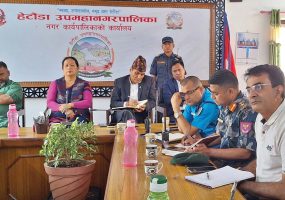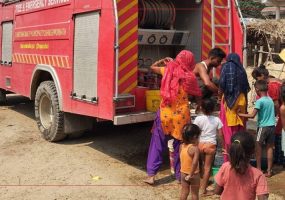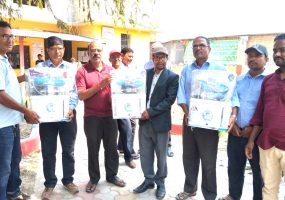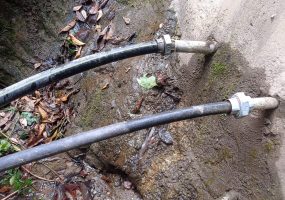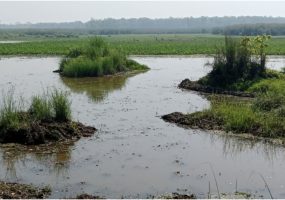
Article Info
This article has been prepared in two consecutive series in relation to the sustainable urban water management in Kathmandu. The first series of this article depicts the current status of Kathmandu’s urban water management from the lens of sustainability. Whereas the later series (Series-II) will deal with the possible improvement measures for sustaining urban water management in cities like Kathmandu.
Abstract
The paper explores the urban water management scenario in Kathmandu through the lens of sustainability with an aim to shed light on the various facets of urban water management in Kathmandu, associated complexities, and its implications for sustainability. It investigates the status of urban water management in Kathmandu, focusing on various aspects such as water sources, use of water sources, and status of water services. Furthermore, it also discusses from the lens of sustainability, examining challenges such as rapid urbanization, its pressure, limited and aging infrastructures, and encroachment in natural water bodies, climate change impacts, and poor governance.
Analysing the strengths and weaknesses of the current institutional setup, it identifies key government entities responsible for urban water management. While strengths include centralized coordination and technological integration; weaknesses such as inadequate infrastructure, funding constraints, community engagement and weak enforcement hinder effective water management. It evaluates strategies adopted from a sustainability perspective, pointing out issues such as top-down approaches, unattainable targets, lack of long-term planning, economic barriers, resistance to change etc. It emphasizes importance of community engagement, effective communication, and regulatory enforcement to ensure success of sustainable water management strategies.
Overall, the paper provides a comprehensive overview of the urban water management landscape in Kathmandu, highlighting the challenges and opportunities for achieving sustainability in water management practices. It calls for collaborative efforts among stakeholders to address the complexities and ensure a resilient and sustainable urban water cycle in Kathmandu. It highlights the need for holistic water management approaches that consider the entire watershed level to ensure water security, integrate nature-based solutions, community engagement, and effective governance mechanisms to ensure the resilience and sustainability of the urban water cycle in Kathmandu.
Method(s)
✓ Analysis through secondary literatures, to inform practitioners, professionals, decision, and policy makers for their understanding in managing current urbanization growth and its subsequent consequences on the sustainability aspects of Kathmandu’s Urban Water Cycles.
✓ This article has been prepared entirely based on author’s own perceptions, experiences, with reference to the related secondary information and city dwellers’ perceptions. The audiences may have agreements, disagreements, critics and may have entirely different views than what has been mentioned here. All are always welcome and appreciable for bestowing the respect to the lens of the author in looking at the Kathmandu’s current urban water management scenario.
Key Words:
✓ Urban Water Cycles, Urbanization, City characteristics
✓ Institutional set-up
✓ Sustainability, Improvements, criteria, frameworks, strategies for Sustainable Urban Water Cycles
✓ Integration, community engagement, water management, nature-based solution, climate resilient,
✓ Policy, regulation, coordination, services, tariff, economic barriers, revenue
Urban Water Management in Kathmandu
The urban water cycles of Kathmandu from the lens of its current management discourse has been discussed in the first series (SERIES-I) of this article from the following aspects:
a. Current status
b. Lens of sustainability
c. Strength and Weakness of the current existing institutional set up.
d. Strategies adopted rendered unsuccessful.
a. Current Status
It’s important to understand that the specifics of the urban water cycle can vary significantly depending on the city’s geography, climate, population density, and available water resources. The urban water cycle in Kathmandu, Nepal, therefore, typically involves several key stages of the water service chain that includes availability of water sources, water extraction, water treatment, water distribution, and wastewater generation etc. and so on.
Currently in Kathmandu,
· Water services are sourced from surface and ground water sources from different parts within and outside and delivered/supplied by a utility to the users (i.e. institutions, businesses, and HHs).
· To manage sanitation, there is a sewer system but limited coverage and limited treatment before disposal to water bodies. Alongside, there is many septic tanks and pit latrines of unknown quantity and quality – all these are the potential sources of pollution and environmental risk.
· Limited areas for vegetation for supplementation to the underground aquifer, thus affecting hydrological phenomena such as evapo- ranspiration, runoff, and infiltration etc. to a greater extent.
The urban water cycle in Kathmandu, as in other cities, requires careful management to ensure a sustainable and resilient water supply for the growing population while addressing challenges such as water scarcity, pollution, and infrastructure maintenance. Therefore, urban water management in Kathmandu as in many other cities is affected by the city characteristics, particularly its urbanization pattern and its land use pattern.
Kathmandu city’s water cycle is currently characterized by
· High urbanization with highest urban growth in South Asia, meaning high urban population due to migration for safer places, high growth opportunities, better living with high quality of services compared to other parts of the country.
• More pressure on urban amenities and services is undermining the thoughtful exploitation of the natural resources and overlooking the water security through integrated water management considering holistic approach through the entire watershed level.
· Not aligned the urban water cycle of Kathmandu with holistic watershed concept promoting water security through one water approach for efficient water management practices not limited to administrative boundaries but the entire watershed level of Kathmandu – which is often ignored or neglected by the authorities.
· Though high urbanization rate prevails, but equally unplanned, it overwhelms urban utilities and services with limited capacity of the urban authorities.
· With the urbanization, Kathmandu city is prevailed with more built-up areas encroaching the natural ground and water bodies including the traditional water sources and recharge ponds as well as deteriorating the pathways of natural flow of water to the water points like stone spouts or traditional wells – thereby leading to non-functional or low yield because of the encroachment of the recharged areas and flow pathways.
· Increased overland flow and runoff due to obstruction in the recharge or infiltration of the runoff due to unplanned growth of the city caused by ever increasing urban population and unplanned physical infrastructures.
· Management of wastewater is extremely poor affecting the water bodies and rivers which at present are more or less dead. Similarly, stormwater drainage management and sewer management is either very poor or exhaustive or not properly existed to accommodate the current trend of Kathmandu’s urbanization.
· Natural infiltration in Kathmandu has been drastically reduced due to concretization of the city and ever-increasing built-up area and ever decreasing natural open spaces for buffering the flood through natural recharge adopting NBS to augment the ground water source.
The Result
· Heavy rainfall leads to accelerated runoff causing flooding that leads to natural disaster – this type of event is now being observed more frequently in Kathmandu which otherwise in the past at least 10 years from now was hardly experienced.
· Changes in the precipitation pattern are being experienced reflecting climate variability in the city; and similar situations with the weather changing pattern.
· Reduction of flow in the rivers rendering them dead due to over discharge of untreated wastewater than its dilution capacity. Similarly, depletion in groundwater led by its thoughtless exploitation.
· Negative impact on Agriculture (irrigation); WASH, and of course energy and environment.
b. Lens of Sustainability
The current urban cycles of Kathmandu at present cannot be considered sustainable because – in one hand, it does not align with the natural hydrological cycle and principles; whereas on the other, City continues to expand with new developments without little or in fact not considering the sustainability aspects of urban water cycle i.e. in terms of water usage, conservation and management within that area adopting one water lens.
Though, the sustainability assessment of an urban water cycle involves evaluating various factors related to status of the water sources, usage, conservation, augmentation, their quality state and overall management and protection from their deterioration thereby leading to environmental degradation rendering them unsuitable to use and reuse. Therefore, in this discussion, following factors need to be considered for ensuring sustainable urban water cycle in a city like Kathmandu.
Sustainable urban water cycle in Kathmandu, are being affected by the following challenges: and these challenges need to be critically considered and addressed through policy actions, strengthening accountability, and capacity enhancement for institutionalization:
· Rapid urbanization and population growth are straining the existing water resources and infrastructure, challenging the sustainability of the water cycle.
· Aging water infrastructure is leading to leaks, inefficiencies, and increased maintenance needs thereby deteriorating the services. Similarly, unplanned infrastructure interventions are gradually being experienced as counterproductive. Such development actions are thus impacting the overall sustainability of the urban water cycle system.
· Changes in climate patterns are affecting the water availability, precipitation, and stormwater management, posing challenges to the sustainability of urban water cycles.
· Ill-managed rivers and depleting groundwater, negligible recharge practices, and minimal practices of adopting NBS techniques like rainwater harvesting, mismanagement of wastewater, sewers and on-site sanitation; exists very minimal practices of efficient water usage, and policy incentives for encouraging efficient water use practices, Nature Based Solutions (NBS) for water conservation, reducing wastewater, enhancing water augmentation and recycling wastewater etc. are either negligible or non-existent – Thus resulting towards unsustainable urban water cycle in Kathmandu City.
· Inefficient management of storm water and wastewater, in fact poor management practices, often led to poor water quality either for drinking purpose or of the water bodies; ownership and participation of the urban communities like that of Kathmandu is not to the mark particularly water conservation efforts, raising awareness about sustainable water practices, and promoting community participation contribute towards sustainable urban water cycle in the cities like Kathmandu– Questionable to the sustainability of the water cycle.
· Water resource management, including land-use planning and regulations could help address water challenges to contribute to long-term sustainability – if it had been well planned, integrated, and guided by the policy and actions with rewards and punishment together with the good understanding on the water resource management to promote water security analyzing from one water lens. If planning for climate change impacts and variability had been ensured, the resilience and sustainability in the face of rapidly changing conditions could have been experienced by Kathmandu city.
· Effective water governance and regulation are crucial for enforcing water management practices and addressing potential issues. However, the current weak governance practices are hindering sustainability efforts to a greater extent.
Problematic behaviors of City Dwellers and some of them, which can be considered as indirect factors, are discussed below.
✓ Excessive Water Consumption with thoughtless exploitation of the available natural water resources (be it surface or ground water) thus straining the local water resources and contributing to the increased level of pollution. This situation has contributed to the thoughtless exploitation of the available natural water resources be it surface water or ground water thus leading excessive abstraction of these water resources. There are ample examples such as land subsidence, depleted water tables due to excessive abstraction of GW.
✓ Unwillingness to pay for the services and thus practice illegal connections and pumping through unauthorized water tapping or connections for water theft without recording water usage through the meter. Similarly, some city dwellers use water inefficiently, and adopts inefficient water fixtures etc. leading to ineffective water use, wastage of water, and ill management of water by the city dwellers thus contributing to unnecessary water consumption, strain the water supply system and ultimately the entire available water resources. All these behaviors of the city dwellers contribute to increase the Non-Revenue Water (NRW) of the municipal water utility. This further led to financial losses to the city water authority which at the end of the day affect its ability to provide reliable and affordable water services law-abiding citizens i.e. paying customers.
√ Excessive increase in the Impervious Surfaces (due to increase in the buildings, pavements, concretization etc. and unplanned and haphazard growth of the city) in the city has contributed to the extreme shortage of green spaces and green infrastructures (e.g. permeable pavements or pervious surfaces for surface infiltration for recharging GW, rain gardens etc.) and contributed to reducing natural infiltration of surface runoff and rainwater. This has hindered the natural water recharging through surface infiltration and led to the exacerbating urban heat effects; increased runoff, erosion, flooding; and decreasing GW recharge reducing the potential buffer to tackle with the monsoon led flood disaster. This is being experienced by the city in an increasing trend.
✓ Some dwellers often misuse and indiscriminately dispose solid wastes including litter and hazardous materials etc. improperly into drainage ditches or direct discharge its faecal sludge or sewerage to the water bodies without adequate treatment practices thus exacerbating sanitation issues, contributing contamination/pollution and affecting water quality ultimately. Besides, the discharge of pollutants from industrial facilities (be it small scale or large), and residential areas, such as fertilizers, pesticides, and chemicals, can negatively impact water quality and rendering them unsuitable for consumption thereby adversely affecting the water cycle of the city. All these contributed to transforming the rivers that pass through the city to their dead stage which one can easily understand and experience from their current situation.
✓ Lack of governance, regulation and enforcement mechanism are making people reluctant to demand for the effectively managed services; neither the people can make the city authority, concerned government institutions and the people’s leaders accountable for their responsibilities.
Lastly, to be more precise and accurate in understanding Kathmandu’s urban water cycle and its sustainability, it is necessary to assess and analyse specific data, policies, and practices (existed in the city) technically; and require intersectoral approaches with a strong sense of responsiveness and accountability for longer term planning. Equally important is to consider good governance practices, community engagement for their ownership and ensuring responsive services considering addressing the factors & challenges (as mentioned above) through any initiatives related to resilient water management endeavours but not solely limiting to infrastructure development only. In addition, this requires critical thinking of having a combination of sustainable urban planning, water conservation measures, efficient infrastructure, and community awareness to ensure the long-term sustainability of the water cycle in the city areas. It’s important for local governments, residents, and businesses to work collaboratively to mitigate these challenges.
c. Strength and Weakness of the Current Existing Institutional Set-up
The currently responsible entity for urban water cycle management in the Kathmandu can broadly be categorized into the following key responsible government institutions:
• Federal Government: overall responsibility of the nation and if the issues or interventions go beyond the jurisdiction of one provincial state. This includes the federal ministries related to Water resource, Water Supply, Federal Affairs & General Administration, Hydrology and Metrology, and Finance; and their respective Departmental Units, Project Implementation Directorates, Regulatory Authorities and Utilities (like Kathmandu Upatyaka Khanepani Limited, Melamchi Water Supply Project etc.).
• Local Government: Metropolitan Cities of Kathmandu Valley has the overall responsibility in making sure that the city is provided with the appropriate and safely managed services. Besides, the infrastructure unit, social development unit as well as financing unit should work together with the concerned city/municipal/urban authorities for better urban water cycle management endeavors.
Based on global trends and local practices, the strengths and weaknesses that are found in the current existing institutional setup in Kathmandu can be briefly discussed below, particularly its strengths and weakness from the perspective of urban water cycle management.
Strengths :
• Having a dedicated Authority that adopts a more centralized approach can lead to better coordination and streamlined decision-making for proper water management.
• Incorporating advanced technological integration enhances the efficiency of data collection, monitoring, and management.
• Active involvement of the local communities in water management decisions leads to a stronger support for sustainable practices and a better understanding of local water issues and contexts.
• Well-defined policies and regulations for water management, including water quality standards for managing and control over the urban water cycle.
Weakness :
• In effective of coordination among different government agencies and stakeholders often leads to fragmented governance resulted by fragmented decision-making and challenges in implementing comprehensive water management strategies.
• Insufficient or inadequate water infrastructure or whatever available are aging etc. is hindering for effective water distribution, treatment, and sanitation, leading to issues such as leaks, contamination, and inefficiencies.
• Insufficient funding or limited financial resources is constraining the implementation of sustainable water projects, hindering investments in infrastructure, technology, and community education programs.
• In most cases, there exists a lack of transparency in sharing water-related data with the public, hindering informed decision-making and reducing trust in water management efforts.
• Insufficient and inadequate capacity both in terms of resources (human and equipment) or in terms of performance led to the challenges in addressing complex issues and adopting innovative solutions.
• Weak enforcement of water-related polices, regulations frameworks resulted in non-compliance, pollution, and unsustainable water use practices.
• Limited factoring of climate change impacts or climate resilience aspects into the water management plans resulted many challenges in adapting to extreme weather events, affecting water availability and sustainability of infrastructures.
• Lack of comprehensive public awareness programs and people’s limited understanding about the importance of water conservation and sustainable practices among residents etc. are affecting the urban water cycle tremendously.
• Performance Evaluation and Accountability: Either there is not a system or if exists not properly functioning system for regular performance evaluations of the water management authority and other relevant agencies. Similarly, the existing mechanisms for accountability also does not ensure the defined roles and responsibilities to fulfil the goals required to be met for sustainability.
• Continuous evaluation and adaptation of institutional mechanisms is crucial to meet the evolving challenges of urbanization and environmental change, but not found adopted and practiced diligently.
It’s important to note that the strengths and weaknesses can vary significantly according to the perceptions of the people; and one thing is certain that the improvements in the urban water management system often requires a multifaceted approach involving collaboration among government entities, communities, and other stakeholders.
d. Strategies currently adopted from the lens of sustainability.
In Nepal, particularly in Kathmandu city, the government of Nepal together with Municipal authorities, conceptualized, adopted, and executed different strategies. Melamchi water project, Bagmati river cleaning campaign, conservation of Bagmati civilization etc. and many more of such initiatives to discuss on how they are not working effectively for sustainability of the urban water in the city. While considering the effectiveness of these strategies from the context of execution, these initiatives faced challenges or proved less successful. Here are some reasons why these strategies faced difficulties and challenges that is driving them towards unsuccessful:
• Top-Down Approaches: Imposing strict regulations or mandates without considering the active engagement of the community in development initiatives may lead to resistance or lack of compliance. The current strategy adopts less engagement of the community beneficiaries in fact negligible. This lacks effective, sufficient, inclusive, equitable, meaningful, and stronger community participation of the mass people in the urban development endeavors in Kathmandu city has not been able to bring meaningful change in water conservation, responsible water use, and proper waste and wastewater management practices etc. and so on. Because of this top-down approach, it was also merely adopted to perceive and plan and accelerate the nature-based solutions techniques and climate resilient approaches ensuring public awareness and strong community engagement for the preservation of water sources and infrastructure improvements and developments for holistic development of the city to align with the trend of urban growth.
• Unattainable and over ambitious Targets were set without considering their practicality and feasibility for residents. This resulted in frustration and non-compliance both at the city dwellers as well as with the concerned authorities. This has been further exacerbated by the execution of complex technological Solutions without ensuring Public Understanding which has thus led to their underutilization or misuse.
• Long-term planning and strategy: Though the mentioned projects and campaign initiatives were initiated, but as a part of their execution, one can easily understand that the adopted strategies lack longer term visions and planning but focuses solely on short-term gains without considering long-term sustainability. As a result, this seems not in a position to reap the benefits for lasting changes among the city dwellers in fact the turtle speed of the progress in achieving its anticipated changes and benefits be it to the city dwellers (citizens) or be it to the environmental resources with pollution free environment with abundant water availability for drinking and to replenish the river water that are currently at the dead stage. Besides, the strategies also lack focus on promoting responsible practices and fostering the importance of communities’ engagement and participation.
• Vulnerability Analyss: The vulnerability analysis of the city from different lenses such as environmental aspect, continuing urbanization; on-going experiences of risks natural, climate induced and anthropogenically impacted disasters etc. is lacking. This has not been given due consideration by the city planners, authorities, policy & decision makers and even the urban city dwellers during their journey of city development to accommodate current urban growth and urbanization trend to ensure the city resilient against the vulnerabilities that can be induced by climate and nature induced disaster and risks and make city resilient and sustainable city.
• Economic Barriers due to high costs of water facilities/services adopting sustainable technologies and impeding of their widespread adoption among the city dwellers. On top of that, Inequitable Distribution of Resources among certain demographics or neighborhoods exacerbate socio-economic, environmental, and political inequalities and conflicts.
• Incremental increment tariff: It is a good strategy to set different tariff rate for the people from different income levels i.e. incremental increment tariff; but there does not exist a clear plan for implementing the affordable tariff rate considering the economic status of the low-income community and poor, marginalized and excluded communities. This resulted low turnover city dwellers in terms of revenue contributions and rendered them as high Non-Revenue Water (NRW) for the city authorities/water utility who considered it as water leakage/loss.
• Lack of Collaboration or limited interagency collaboration, coordination and consultation between different government agencies, departments, municipal authorities, and community stakeholders resulted the hinderances to the effective adaptation and implementation of comprehensive water management, environment, and ecosystem management strategies. This resulted to the coordination gap, lack of enforcement mechanism, top-down approach, focusing primarily on physical aspects without genuine participation from city dwellers.
• Resistance to Change: The prevailing cultural attitudes or long-standing habits in most of the cases resisted changes in water consumption, use and management practices and behaviors, making it highly challenging to implement sustainable strategies. This is particularly because of the poor and inadequate communication about the reasons behind water management and conservation efforts, the benefits, and the consequences of non-compliance etc. This has ultimately led to a lack of understanding and support from the community(s) to the city authority and water utility to the level of their expectations.
• Regulatory enforcement and restrictions related to water use, conservation, and management are not adequately enforced. Regulatory measures including penalties for water misuse and improper waste management are not properly and adequately adopted. Thus, the desired impact on behavior has not been achieved as expected and desired.
It’s essential to recognize that the success of strategies depends on the specific context, community engagement, effective communication, and ongoing evaluation and adjustment. Learning from both successful and unsuccessful experiences can contribute to the development of more effective and tailored approaches to ensure the sustainability of the water cycle in urban areas like Kathmandu city. There are still ample of opportunities for city/municipal authority of Kathmandu and concerned government authorities to address the challenges faced by the city due the strategies currently adopted and these strategies are seemingly transforming towards unsuccessful for the sustainability of urban water management.
Author is a WASH development professional and demonstrated his expertise (both technical and management endeavors) on water management, urban sanitation, and climate resilient initiatives to WASH. His email for any correspondence (if one wishes) is kabirdas2079@gmail.com.
This article has been prepared in two consecutive series in relation to the sustainable urban water management in Kathmandu. The first series of this article depicts the current status of Kathmandu’s urban water management from the lens of sustainability. Whereas the later series (Series-II) will deal with the possible improvement measures for sustaining urban water management in cities like Kathmandu. This article has been prepared entirely based on author’s own perceptions, experiences, with reference to the related secondary information and city dwellers’ perceptions. The audiences may have disagreements, critics, and entirely different views than what has been mentioned here. All are always welcome and appreciable for bestowing respect to the lens of the author in looking at Kathmandu’s current urban water management scenario.

 1197 पटक हेरिएको
1197 पटक हेरिएको 



